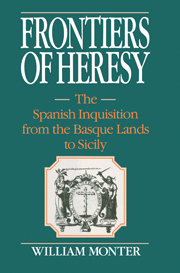Book contents
- Frontmatter
- Contents
- List of maps and figure
- List of tables
- Preface
- PART 1 THE HOLY OFFICE OUTSIDE CASTILE
- I The Castilian Inquisition in the Crown of Aragon, 1484–1530
- 2 The Aragonese century of the Spanish Inquisition, 1530–1630
- 3 The Aragonese Secretariat: public and private faces
- PART 2 ARAGONESE TRIBUNALS
- PART 3 ARAGONESE HERESIES
- PART 4 “MIXED CRIMES” IN ARAGON
- PART 5 RECESSIONAL
- APPENDICES
- Glossary
- Index
- CAMBRIDGE STUDIES IN EARLY MODERN HISTORY
2 - The Aragonese century of the Spanish Inquisition, 1530–1630
Published online by Cambridge University Press: 24 October 2009
- Frontmatter
- Contents
- List of maps and figure
- List of tables
- Preface
- PART 1 THE HOLY OFFICE OUTSIDE CASTILE
- I The Castilian Inquisition in the Crown of Aragon, 1484–1530
- 2 The Aragonese century of the Spanish Inquisition, 1530–1630
- 3 The Aragonese Secretariat: public and private faces
- PART 2 ARAGONESE TRIBUNALS
- PART 3 ARAGONESE HERESIES
- PART 4 “MIXED CRIMES” IN ARAGON
- PART 5 RECESSIONAL
- APPENDICES
- Glossary
- Index
- CAMBRIDGE STUDIES IN EARLY MODERN HISTORY
Summary
No es más rey Vuestra Majestad en España de cuanto fuere favorecido el Oficio de la Inquisición con rigor.
Inquisitor-General Valdés to Philip II, 1559 (Novalin, Valdes, I, p. 233).C'est l'Inquisition qui les tient en bride, et ne scauriot estre trop rigoreuse envers eux, car sans la terreur et la crainte d'icelle, il y auroit plus grand nombre de Marranos en Espagne que de Loutheranos en France.
André Favyn, Histoire de Navarre (1610) (cited by Caro Baroja, Judios en la España, I, pp. 484–85).II Consiglio d'Inquisizione … è il più assoluto Consiglio della corona di Spagna perchè, sotto capo di religione, s'ascondono le più recondite massime del governo spagnuolo
Venetian ambassador, 1649 (Firpo, Relazioni, X, p. 152).Nowhere in the meticulous and distinguished work of Henry Charles Lea can one find any attempt to break the long history of the Spanish Inquisition into separate periods. Neither he nor lesser historians ever tried to identify distinct phases of greater or lesser inquisitorial activity, or show shifts in the priorities preoccupying the Holy Office. Both Lea and his critics argued passionately about the total number of people ever put on trial or executed by the Inquisitors; but everyone had to begin by manipulating or criticizing the same figures, originally proposed by the renegade inquisitorial official Juan Antonio Llorente in the early nineteenth century.
- Type
- Chapter
- Information
- Frontiers of HeresyThe Spanish Inquisition from the Basque Lands to Sicily, pp. 29 - 54Publisher: Cambridge University PressPrint publication year: 1990



